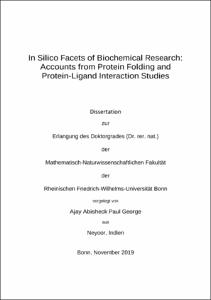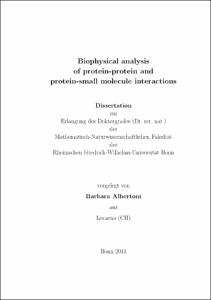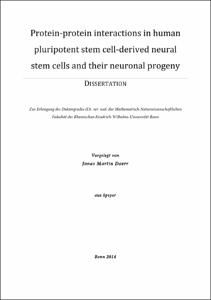Paul George, Ajay Abisheck: In Silico Facets of Biochemical Research: Accounts from Protein Folding and Protein-Ligand Interaction Studies. - Bonn, 2020. - Dissertation, Rheinische Friedrich-Wilhelms-Universität Bonn.
Online-Ausgabe in bonndoc: https://nbn-resolving.org/urn:nbn:de:hbz:5-59501
Online-Ausgabe in bonndoc: https://nbn-resolving.org/urn:nbn:de:hbz:5-59501
@phdthesis{handle:20.500.11811/8575,
urn: https://nbn-resolving.org/urn:nbn:de:hbz:5-59501,
author = {{Ajay Abisheck Paul George}},
title = {In Silico Facets of Biochemical Research: Accounts from Protein Folding and Protein-Ligand Interaction Studies},
school = {Rheinische Friedrich-Wilhelms-Universität Bonn},
year = 2020,
month = sep,
note = {Exponential advancements in computer technology over the last five decades have ubiquitously benefited science and humanity as a whole. Consequent beneficiaries of this surge of computational power include all subfields of science that fall under the umbrella of “biochemical research”. Specifically, proteins, possibly the most versatile of all biological macromolecules, have always been the subject of extensive experimental investigation and more so from a pharmaceutical perspective, since the majority of pharmaceutical drugs target proteins. In silico methods assist experimental research on proteins in multiple ways ranging from relatively simple tasks such as organizing sequences and structures in biological databases to providing atomistic level insights into the structure and dynamics, that form the basis of the biological function of the protein. Given the unquestionable certitude that the three-dimensional structure of the protein determines its function, understanding the formation of structure from sequence, i.e. protein folding, is a central theme of investigation. Despite massive improvements in the understanding of protein folding over the last 50 years, it still remains an unsolved problem.
Herein, computational approaches involving a combination of molecular modeling and biomolecular simulations are pursued to study important biochemical phenomena, namely, protein folding and protein-ligand interactions. In terms of protein folding, a specific problem, i.e. oxidative self-folding is investigated. Oxidative folding refers to folding that involves the covalent linkage of cysteine residues in proteins to form disulfide bonds that stabilize the folded structure. Disulfide bonds play multifaceted roles in the peptides and proteins that they occur in, from providing structural integrity to acting as allosteric switches that regulate function. Current knowledge on oxidative folding has been restricted to consensuses derived from observing the folding of various model peptides and proteins. Most notably, the oxidative folding pathways of the proteins bovine pancreatic trypsin inhibitor (BPTI) and hirudin have been used as extreme models based on the manner in which the disulfide bond formations occur. However, the folding of a large group of such disulfide-rich peptides and proteins has been vaguely described to fall in between these extreme models. In this study, conotoxins, a class of venom peptides derived from marine cone snails of the genus Conus are used as candidates to study their oxidative folding, and to determine their place between the aforementioned extremes defined by BPTI and hirudin. With their ability to potently and selectively block voltage-gated sodium channels, conotoxins invoke broader a pharmaceutical interest than being mere model peptides to study oxidative folding. Furthermore, disulfide isomers of tridegin, a 66mer peptide produced by the giant Amazon leech Haementeria ghilianii are investigated for the role of disulfide bonds concerning folding, stability and function. The pharmaceutical significance of tridegin is that, it is the only known peptide inhibitor of the blood coagulation factor XIIIA, and shows great promise as a lead substance in anti-coagulation therapy.
Heme being an effector molecule, conveys a regulatory effect on the proteins it binds to, affecting their physiological functions. Protein-ligand interactions in the form of the transient binding of heme to proteins is investigated herein using molecular docking and molecular dynamic simulations. Finally, a decade’s worth of experimental knowledge obtained on transient heme-protein interactions is presented as an algorithmic implementation to predict transient heme-binding motifs in protein sequences, enabling the identification of novel heme-regulated proteins. Overall, this work serves as a testament to the growing significance of in silico methods in aiding experimental biochemical research.},
url = {https://hdl.handle.net/20.500.11811/8575}
}
urn: https://nbn-resolving.org/urn:nbn:de:hbz:5-59501,
author = {{Ajay Abisheck Paul George}},
title = {In Silico Facets of Biochemical Research: Accounts from Protein Folding and Protein-Ligand Interaction Studies},
school = {Rheinische Friedrich-Wilhelms-Universität Bonn},
year = 2020,
month = sep,
note = {Exponential advancements in computer technology over the last five decades have ubiquitously benefited science and humanity as a whole. Consequent beneficiaries of this surge of computational power include all subfields of science that fall under the umbrella of “biochemical research”. Specifically, proteins, possibly the most versatile of all biological macromolecules, have always been the subject of extensive experimental investigation and more so from a pharmaceutical perspective, since the majority of pharmaceutical drugs target proteins. In silico methods assist experimental research on proteins in multiple ways ranging from relatively simple tasks such as organizing sequences and structures in biological databases to providing atomistic level insights into the structure and dynamics, that form the basis of the biological function of the protein. Given the unquestionable certitude that the three-dimensional structure of the protein determines its function, understanding the formation of structure from sequence, i.e. protein folding, is a central theme of investigation. Despite massive improvements in the understanding of protein folding over the last 50 years, it still remains an unsolved problem.
Herein, computational approaches involving a combination of molecular modeling and biomolecular simulations are pursued to study important biochemical phenomena, namely, protein folding and protein-ligand interactions. In terms of protein folding, a specific problem, i.e. oxidative self-folding is investigated. Oxidative folding refers to folding that involves the covalent linkage of cysteine residues in proteins to form disulfide bonds that stabilize the folded structure. Disulfide bonds play multifaceted roles in the peptides and proteins that they occur in, from providing structural integrity to acting as allosteric switches that regulate function. Current knowledge on oxidative folding has been restricted to consensuses derived from observing the folding of various model peptides and proteins. Most notably, the oxidative folding pathways of the proteins bovine pancreatic trypsin inhibitor (BPTI) and hirudin have been used as extreme models based on the manner in which the disulfide bond formations occur. However, the folding of a large group of such disulfide-rich peptides and proteins has been vaguely described to fall in between these extreme models. In this study, conotoxins, a class of venom peptides derived from marine cone snails of the genus Conus are used as candidates to study their oxidative folding, and to determine their place between the aforementioned extremes defined by BPTI and hirudin. With their ability to potently and selectively block voltage-gated sodium channels, conotoxins invoke broader a pharmaceutical interest than being mere model peptides to study oxidative folding. Furthermore, disulfide isomers of tridegin, a 66mer peptide produced by the giant Amazon leech Haementeria ghilianii are investigated for the role of disulfide bonds concerning folding, stability and function. The pharmaceutical significance of tridegin is that, it is the only known peptide inhibitor of the blood coagulation factor XIIIA, and shows great promise as a lead substance in anti-coagulation therapy.
Heme being an effector molecule, conveys a regulatory effect on the proteins it binds to, affecting their physiological functions. Protein-ligand interactions in the form of the transient binding of heme to proteins is investigated herein using molecular docking and molecular dynamic simulations. Finally, a decade’s worth of experimental knowledge obtained on transient heme-protein interactions is presented as an algorithmic implementation to predict transient heme-binding motifs in protein sequences, enabling the identification of novel heme-regulated proteins. Overall, this work serves as a testament to the growing significance of in silico methods in aiding experimental biochemical research.},
url = {https://hdl.handle.net/20.500.11811/8575}
}









